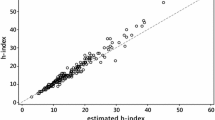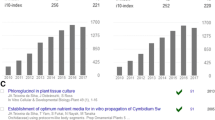Abstract
It is known that the H-indexes of individuals, research groups, institutions, scientific journals, and countries strongly depend on the field of study, slowly increase with the number of publications, N, and can be described by empirical power-law functions of the type H = C × Na (C and a are constants and depend on the specific field being analyzed). In this paper, we use this function and propose a new index [Montazerian–Zanotto–Eckert (MZE)], which is normalized by the number of publications and typically varies from − 1 to + 1, to characterize the relative standing of a research group, institution, or author to those of his/her peer groups. Due to the rich statistics available, as an example, here we analyzed and tested the new parameter against the citation-related performance (H-index) of countries. We found that the MZE index readily distinguishes between countries that stand above or below the average (for any given number of publications). Generally, publications of countries with a positive MZE index are more interesting or visible than the average. Analyzing publication output in this manner instead of the H-index allows for a less biased comparison between researchers, journals, universities, or countries for any particular combination of H-index and publication output.







Similar content being viewed by others
References
Alonso, S., Cabrerizo, F. J., Herrera-Viedma, E., & Herrera, F. (2009). H-index: A review focused in its variants, computation and standardization for different scientific fields. Journal of Informetrics, 3(4), 273–289.
Babić, D., Kutlača, Đ., Živković, L., Štrbac, D., & Semenčenko, D. (2016). Evaluation of the quality of scientific performance of the selected countries of Southeast Europe. Scientometrics, 106(1), 405–434.
Braun, T., Glänzel, W., & Schubert, A. (2006). A Hirsch-type index for journals. Scientometrics, 69(1), 169–173.
Csajbok, E., Berhidi, A., Vasas, L., & Schubert, A. (2007). Hirsch-index for countries based on Essential Science Indicators data. Scientometrics, 73(1), 91–117.
Dutta, S., Lanvin, B., & Sacha Wunsch-Vincent, S. (Eds.). (2017). The Global Innovation Index 2017: Innovation Feeding the World. New York: Cornell University, INSEAD, WIPO.
Editorial. (2005). Not-so-deep impact. Nature, 435(7045), 1003–7431.
Egghe, L. (2006). Theory and practice of the g-index. Scientometrics, 69(1), 131–152.
Egghe, L. (2010). The Hirsch index and related impact measures. Annual Review of Information Science and Technology, 44(1), 65–114.
Egghe, L., & Rousseau, R. (2006). An informetric model for the Hirsch index. Scientometrics, 69(1), 121–129.
Glänzel, W. (2006). On the H-index—A mathematical approach to a new measure of publication activity and citation impact. Scientometrics, 67(2), 315–321.
Glänzel, W., & Zhang, L. (2018). Scientometric research assessment in the developing world: A tribute to Michael J. Moravcsik from the perspective of the twenty-first century. Scientometrics, 115(3), 1517–1532.
Guan, J., & Gao, X. (2008). Comparison and evaluation of Chinese research performance in the field of bioinformatics. Scientometrics, 75(2), 357–379.
Hirsch, J. E. (2005). An index to quantify an individual’s scientific research output. Proceedings of the National Academy of Sciences of the United States of America, 102(46), 16569–16572.
Hirsch, J. E., & Buela-Casal, G. (2014). The meaning of the H-index. International Journal of Clinical and Health Psychology, 14, 161–164.
Iglesias, J. E., & Pecharromán, C. (2007). Scaling the H-index for different scientific ISI fields. Scientometrics, 73(3), 303–320.
Ioannidis, J. P. A., Boyack, K., & Wouters, P. F. (2016). Citation metrics: A primer on how (not) to normalize. PLoS Biology, 14(9), e1002542.
Jacsó, P. (2009). The H-index for countries in Web of Science and Scopus. Online Information Review, 33(4), 831–837.
Jin, B., & Rousseau, R. (2005). China’s quantitative expansion phase: Exponential growth but low impact. In Proceedings of ISSI 2005: 10th International Conference of the International Society for Scientometrics and Informetrics (Vol. 1, pp. 362–370).
King, D. A. (2004). The scientific impact of nations. Nature, 430(6997), 311–316.
Meneghini, R., & Packer, A. L. (2006). Articles with authors affiliated to Brazilian institutions published from 1994 to 2003 with 100 or more citations: II—Identification of thematic nuclei of excellence in Brazilian science. Anais Da Academia Brasileira De Ciencias, 78(4), 855–883.
Molinari, J. F., & Molinari, A. (2008). A new methodology for ranking scientific institutions. Scientometrics, 75, 163–174.
Montazerian, M., Zanotto, E. D., & Eckert, H. (2017). Bibliometrics in glass and other sciences: A Plea for reason. International Journal of Applied Glass Science, 8(3), 352–359.
Moravcsik, M. J. (1985). Applied scientometrics: An assessment methodology for developing countries. Scientometrics, 7(3–6), 165–176.
Norris, M., & Oppenheim, C. (2010). The H-index: A broad review of a new bibliometric indicator. Journal of Documentation, 66(5), 681–705.
Panaretos, J., & Malesios, C. (2009). Assessing scientific research performance and impact with single indices. Scientometrics, 81(3), 635–670.
Prathap, G. (2006). Hirsch-type indices for ranking institutions’ scientific research output. Current Science, 91(11), 1439.
Prathap, G. (2010). An iCE map approach to evaluate performance and efficiency of scientific production of countries. Scientometrics, 85, 185–191.
Redner, S. (1998). How popular is your paper? An empirical study of the citation distribution. European Physical Journal B, 4(2), 131–134.
Schubert, A., & Glänzel, W. (2007). A systematic analysis of Hirsch-type indices for journals. Journal of Informetrics, 1(2), 179–184.
SCImago, (2018). SJR—SCImago Journal & Country Rank [Portal]. Retrieved February 4, 2018, from http://www.scimagojr.com.
Taylor, M., Perakakis, P., & Trachana, V. (2008). The siege of science. Ethics in Science and Environmental Politics, 8(1), 17–40.
Van Leeuwen, T. N., Moed, H. F., Tijssen, R. J., Visser, M. S., & Van Raan, A. F. J. (2001). Language biases in the coverage of the Science Citation Index and its consequences for international comparisons of national research performance. Scientometrics, 51(1), 335–346.
Van Raan, A. F. J. (2006). Statistical properties of bibliometric indicators: Research group indicator distributions and correlations. Journal of the American Society for Information Science and Technology, 57(3), 408–430.
Van Raan, A. F. J., Van Leeuwen, T. N., & Visser, M. S. (2011). Severe language effect in university rankings: Particularly Germany and France are wronged in citation-based rankings. Scientometrics, 88(2), 495–498.
Waltman, L. (2016). A review of the literature on citation impact indicators. Journal of Informetrics, 10(2), 365–391.
Waltman, L., & Van Eck, N. J. (2012). The inconsistency of the H-index. Journal of the American Society for Information Science and Technology, 63(2), 406–415.
Wildgaard, L., Schneider, J. W., & Larsen, B. (2014). A review of the characteristics of 108 author-level bibliometric indicators. Scientometrics, 101(1), 125–158.
Wu, R. (2004). Making an impact. Nature, 428(6979), 206–207.
Ye, F. Y. (2011). A unification of three models for the H-index. Journal of the American Society for Information Science and Technology, 62(1), 205–220.
Zanotto, E. D. (2002). Scientific and technological development in Brazil. The widening gap. Scientometrics, 55(3), 411–419.
Zanotto, E. D. (2006). The scientists pyramid. Scientometrics, 69(1), 175–181.
Zhou, P., & Leydesdorff, L. (2006). The emergence of China as a leading nation in science. Research Policy, 35(1), 83–104.
Acknowledgements
The authors are grateful to the São Paulo Research Foundation (FAPESP, # 2013/07793-6) - CEPID/CeRTEV - for financial support of this work and the post-doctoral fellowship granted to Maziar Montazerian (# 2015/13314-9).
Author information
Authors and Affiliations
Corresponding author
Rights and permissions
About this article
Cite this article
Montazerian, M., Zanotto, E.D. & Eckert, H. A new parameter for (normalized) evaluation of H-index: countries as a case study. Scientometrics 118, 1065–1078 (2019). https://doi.org/10.1007/s11192-018-2996-z
Received:
Published:
Issue Date:
DOI: https://doi.org/10.1007/s11192-018-2996-z




